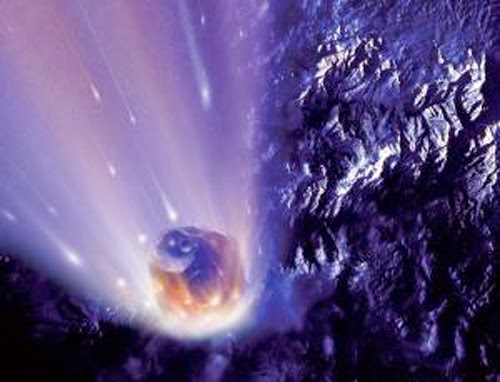
IT WAS a blitzkrieg with no let-up. Earth may have been pounded by massive asteroids for a billion years longer than we thought, with the impacts only stopping about 3 billion years ago. If that is true, early life had to endure a bombardment that periodically melted Earth’s surface.
The planet formed 4.5 billion years ago, and chunks of rock many kilometres across continued falling onto it for hundreds of millions of years. It seemed there was a final burst of impacts around 3.9 billion years ago – and by 3.8 billion years ago it was all over. The first fossils of life are very slightly younger.
That story is wrong, says Donald Lowe of Stanford University in California. The barrage continued far longer. “Its termination was not an abrupt drop-off but a gradual waning until 3 billion years ago,” he says.
Lowe and his colleagues have spent 40 years studying a patch of ancient rocks in eastern South Africa called the Barberton Belt. Over 25 years ago they found four layers of spherical particles, which seemed to have condensed from clouds of vaporised rock. Lowe says they are the traces of four major meteorite impacts, and date from between 3.5 and 3.2 billion years ago.
Now Lowe’s team have described another four layers of spherules from the same period. That means there were eight major impacts within about 250 million years, bolstering the case that the bombardment was still going on (Geology, doi.org/t48).
The moon also bears scars of major impacts up to 3 billion years ago, says William Bottke of the Southwest Research Institute in Boulder, Colorado. “This makes it unavoidable that the Earth was still getting hit by big things late in the game,” he says.
The impacts were on a scale beyond anything that Earth has experienced since the dawn of complex animals. The asteroid believed to have finished off the dinosaurs left a layer of spherules a few millimetres thick. “Our layers are 30 to 40 centimetres,” says Lowe. That suggests the asteroids were at least 20 kilometres across and possibly more than 70. “They were big boys,” says Lowe.
Each impact would have flung huge amounts of rock and gas into the air and blasted a crater 400 to 800 kilometres across. Lowe recently calculated that one such impact would have caused an earthquake that went on for many minutes and tsunamis that could have circled the entire planet.
Such impacts would wipe out most animals and plants if they happened today, but back then all life was single-celled. “We don’t know if this was apocalyptic for the microbes,” says Lowe. Those on the far side of the planet “would have to ride out some large waves” and a rain of hot rocks, but some would surely have survived.
One major group of microbes would have been at more risk: photosynthetic bacteria, which had to live near the surface of the ocean where there was plenty of light. “A very large impact has the potential to evaporate the top 100 metres of the ocean,” says Lowe. “The atmosphere would have heated up to hundreds of degrees Celsius. That would be apocalyptic. If you evaporate below the photic zone, you would obliterate photosynthesis.”
It’s a definite possibility, says Bottke. Such severe impacts could help explain why the air became rich in oxygen only around 2.4 billion years ago. Oxygen is a waste product of photosynthesis, and photosynthetic bacteria may not have been able to gain a foothold on the early Earth under such heavy bombardment. Bottke says there may have been a “back and forth battle”, with life “fighting sporadic setbacks” from asteroid impacts.
Note : The above story is based on materials provided by Michael Marshall “newscientist”










